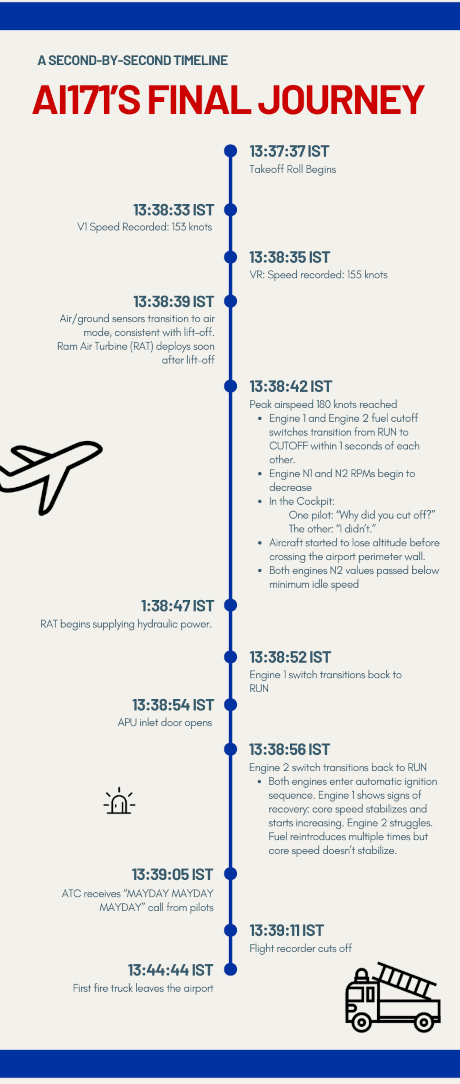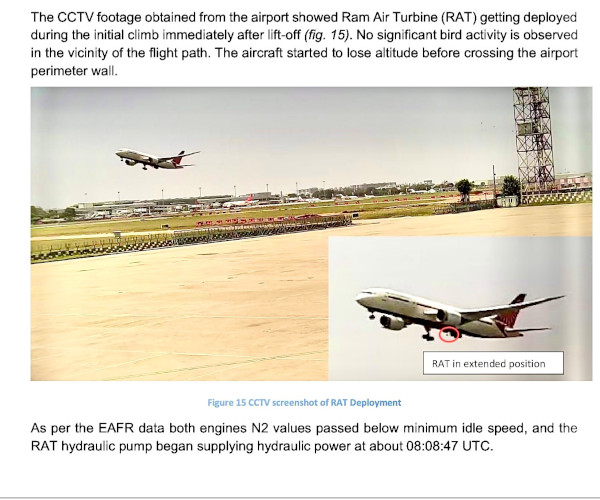[Photo by Aircraft Accident Investigation Bureau - Preliminary Report. Accident involving Air India’s B787-8 aircraft at Ahmedabad on 12 June 2025, Public Domain, via Wikimedia]
It is becoming increasingly clear that human error did not cause the crash of Air India flight AI171.
Instead, mounting evidence points to a possible electronic or electrical systems failure—one that may have occurred seconds before lift-off, perhaps even while the aircraft was still taxiing.
The critical clues lie in the first 61 seconds of the flight, as Captain Sumeet Sabharwal and First Officer Clive Kunder began their takeoff roll at Ahmedabad’s Sardar Vallabhbhai Patel International Airport. A close analysis of this timeline—based on newly released data and a telling CCTV image in the AAIB preliminary report published just after midnight on July 13—begins to unravel what may have really gone wrong.
And it casts serious doubt on a widely circulated theory: that one of the pilots—speculated to be Captain Sabharwal—deliberately shut off the fuel supply, causing both engines to flame out and sending the Boeing 787 Dreamliner crashing into the BJ Medical College hostel in Meghaninagar, just 32 seconds after lift-off.
So, what really happened?
Fasten your seatbelt.
The First 61 Seconds
Focus on the takeoff roll between 13:37:37 IST and 13:38:39 IST. (See graphic AI171’s Final Journey: A Second-by-Second Timeline.)

A key clue appears in Figure 15 on page 14 of the AAIB preliminary report. A CCTV still shows the aircraft approximately 50 feet above the ground, with the terminal building and a parked Air India aircraft visible in the background. But what truly stands out is a second image: the Ram Air Turbine (RAT) is visibly deployed during the aircraft’s initial climb—immediately after lift-off.

[Source: Page 14 of the AAIB preliminary report]
That detail is crucial. Lift-off was recorded at 13:38:39 IST. The RAT appears deployed within a second or two—a highly unusual event.
A Boeing 787 typically climbs at 2,000 to 3,000 feet per minute. At that rate, the aircraft would have reached an altitude of 50 - 100 feet within the first couple of seconds. That the RAT is already deployed at such a low altitude suggests the triggering failure occurred even before the aircraft had left the ground.
While the AAIB report did not timestamp the CCTV images, a detailed LinkedIn analysis by Ranjit John, engineer and founder of Hawkai Data in San Jose, triangulates the image with Google Maps, FlightRadar24, and camera metadata. His conclusion: the image was captured between 08:08:39 and 08:08:40 UTC, placing RAT deployment before the Engine 1 fuel valve was closed at 08:08:42 UTC.
What Triggers the RAT?
The RAT is a small, wind-powered emergency turbine that deploys only under specific conditions: dual engine failure, electrical failure, or hydraulic failure. Critically, it will not deploy while the aircraft is still on the ground—both sets of landing gear must be airborne.
The RAT on AI171 deployed almost immediately after takeoff. According to the AAIB report, it began supplying hydraulic power by 13:38:47 IST—just eight seconds after rotation. That’s slightly longer than typical, possibly because of the unusually low altitude and airspeed at the time.
This timeline strongly supports the theory that the initiating failure occurred before the aircraft left the runway.
Seasoned Air India pilots confirm this sequence is highly irregular. One captain with over three decades of flying experience pointed to the testimony of the sole survivor, who described hearing a loud thud followed by flickering cabin lights changing from yellow to white—classic indicators of RAT deployment.
A Failure to Alert
Here's where things get tricky.
A dual engine failure on the 787 should trigger a series of alerts—chimes, flashing lights, a master warning—and visual messages on the Engine Indication and Crew Alerting System (EICAS). But there is no record of any such warning until 13:38:42 IST, when both engines began to spool down and lose thrust.
That delay raises the possibility of a systems failure—electrical or mechanical—that went undetected by the aircraft’s avionics.
There is precedent. On December 17, 2019, an All Nippon Airways (ANA) Boeing 787 experienced a dual engine shutdown just as the pilot deployed thrust reversers while landing at Osaka. A fault in the avionics caused the aircraft to misread the air - ground transition, shutting down both engines prematurely. Thankfully, the aircraft landed safely.

This wasn’t the first time a fuel switch transitioned from "Run" to "Cutoff" on its own
- Mary Schiavo, aviation lawyer
[Photo from Motley Rice]
In an interview with Financial Express, aviation lawyer Mary Schiavo said this wasn’t the first time a fuel switch transitioned from "Run" to "Cutoff" on its own—it also happened in the ANA incident.
Schiavo, a former Inspector General at the US Department of Transportation and author of Flying Blind, Flying Safe, explained that in the ANA case, the aircraft’s software mistook the plane as being on the ground, triggering the Thrust Control Malfunction Accommodation System to cut off fuel supply—without any manual intervention by the pilots.
She added: “The pilots never touched the fuel cutoff.”
Further complicating matters, the UK Civil Aviation Authority (CAA), just four weeks before the AI171 crash, warned about potential fuel system issues on Boeing aircraft. The FAA had issued an airworthiness directive highlighting risks to the fuel shutoff valves in several Boeing aircraft models, including the 787.
The fuel control switches are housed within the Throttle Control Module (TCM). Although the TCM was replaced on AI171 in 2019 and again in 2023, Air India did not inspect the locking mechanism on the fuel switch—despite a 2018 FAA advisory. The advisory was not mandatory.
When Machines Pretend to Be Men
Software faults in modern aircraft are not new.
In a striking LinkedIn post, Prof. John Thomas, co-chair of MIT’s Engineering Systems Lab, recounted an incident involving an Airbus A330. The pilots had instructed the autopilot to level off at 10,000 ft. As the aircraft entered altitude capture mode, it inexplicably began to descend—as if someone else had taken over control. Both pilots denied touching the controls. Post-flight inspections found no faults. But flight data confirmed the pilots’ accounts: a major software bug in the autopilot had taken control without warning.

Electrical or electronic faults can mimic switch movements
- Ed Pierson, Boeing whistleblower
[Photo from edpierson.com]
In the case of the two 737 MAX crashes (JT610 and ET302), Pierson said FAA and Boeing withheld critical production records, including data on defects in the Electrical Wiring Interconnect System (EWIS). These issues, he alleges, were not disclosed to international investigators or even the US’ National Transportation Safety Board (NTSB).
"Disturbingly,” Pierson wrote, “NTSB Chair Jennifer Homendy has decided not to share these documents with all the parties to the two MAX accident investigations. This is not right and doesn't build international trust."
Could something similar have happened aboard AI171?
With over 1,100 Dreamliners in active service globally, the AAIB will likely move quickly to investigate this further and, if warranted, issue an advisory in the interest of global aviation safety.
The Core Question: Machine or Man?
All signs suggest that the conditions for RAT deployment were already in place when the aircraft was barely airborne. But the root cause—whether dual engine failure or a deeper mechanical or systems malfunction—remains unclear.
Which leads us to the real question: were those conditions created by machine, or man?
Ruling Out Deliberate Action
This is the heart of the matter. How does the evidence stack up against the theory of deliberate pilot action?
If a pilot had intentionally shut off the fuel switches—before, during, or immediately after takeoff—it would have triggered a cascade of warnings: aural alarms, a master warning light, and clear messages on the Engine Indication and Crew Alerting System (EICAS).
However, pilots point out that to minimise distractions during the critical takeoff roll, many EICAS alert messages are automatically suppressed once the aircraft crosses 80 knots. That suppression ends only after takeoff is complete. Even so, a deliberate shutdown of both engines—through manual cutoff—would likely have triggered emergency alerts once airborne.
But there is no record of any such warning until 13:38:42—three seconds after liftoff—when both engines began to spool down and the aircraft started losing thrust.
This strongly suggests the aircraft’s systems may have failed first—catching the crew off guard.
Faced with a sudden and unexplained loss of power, it’s plausible the pilots attempted an emergency engine relight—possibly by toggling the fuel switches off and back on. But by then, it was too late. The aircraft had lost altitude and crashed into the roof of the BJ Medical College hostel.
As more data continues to emerge, it may well be that a small wind-powered emergency turbine—the RAT—turns out to be the unlikely key to understanding what really happened on board AI171.


